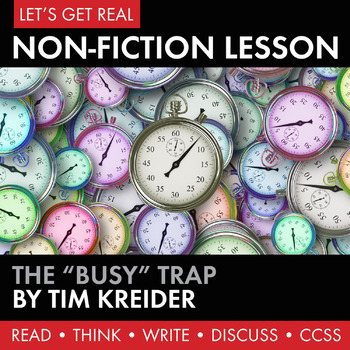Expository, Non-Fiction Lesson on Modern Issues: Benefits of Slacking Off?
- PDF
What educators are saying
Description
The Common Core has a much-greater focus on non-fiction, informational texts in the English/Language Arts classroom. It’s time to start adding more real-world articles and materials to our literary canon. In this easy-to-deliver narrative non-fiction activity, students will read an article by New York Times acclaimed columnist Tim Kreider (link included) and complete a series of deep-thinking questions. Afterward, students will definitely have personal anecdotes and opinions to share about this “Let’s Get Real” classroom activity.
When your principal asks what you’ve done to align your classroom with the Common Core, just point to this non-fiction, expository-based work as an example. This 45-minute lesson will give students a high-quality article to analyze as they make connections between the work and their own lives.
The article presents a compelling argument against the frenetic pace of “busyness” in today’s world and the text-based questions about Kreider’s writing will engage your students and get them thinking about the deeper questions raised by the author.
Begin with a reading of the article (either aloud or solo), have individuals write their answers to the multi-layered depth-of-knowledge questions (either in teams of two or solo), and then launch a class discussion.
The package includes an option for 9th and 10th graders and separate questions for 11th and 12th graders. The article is the same for both groups, but the reflection questions are different, so that various levels of students will find the activity stimulating and challenging. Advanced middle school students should be able to successfully work with the “Level 1” questions, too.
Both sets of questions come with detailed answer keys, of course. You might also want to use the two separate question sheets for differentiated questions within one class.
It usually takes my students 45 minutes to work through the article and give thorough answers to the questions. If you need to extend the lesson, you also could launch a discussion of the issues raised in the article. Your students will have plenty of real-life examples from their own worlds to illustrate Kreider’s points.
These full-class, stand-alone materials also work great as emergency plans for substitute teachers. The material is easy to deliver and the kids will need to work hard for the whole period to finish on time.
Want a similar assignment with a different topic? You can look through all of my non-fiction lessons here:
https://www.teacherspayteachers.com/Store/Laura-Randazzo/Category/Non-Fiction-47646
Thanks for stopping by!





